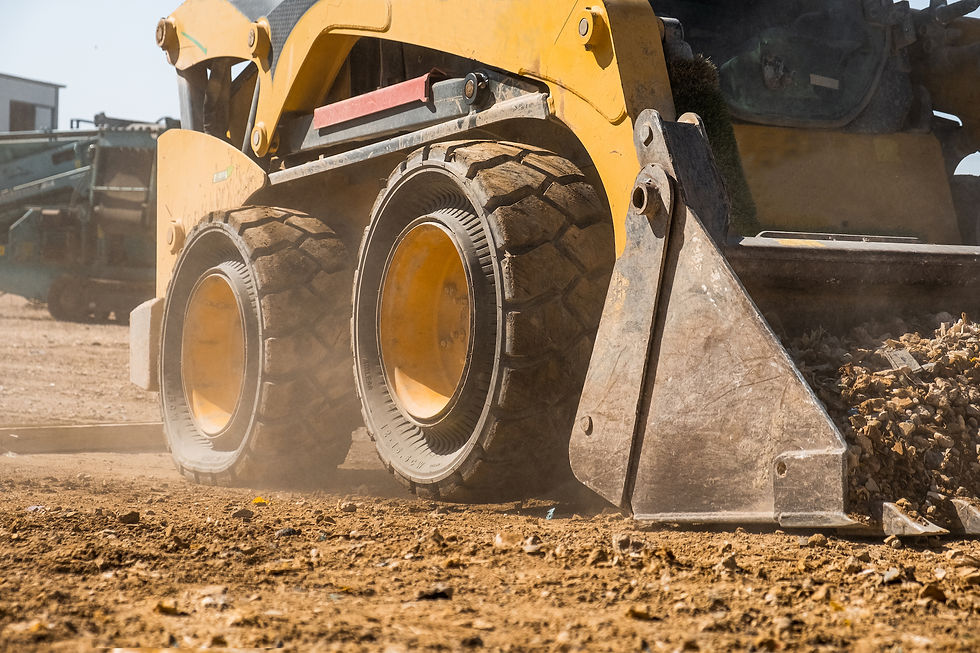Telehandler and Skid Steer Tire Tread Pattern Guide: R4 vs L4 - Which Pattern is Right for Your Application?
- Galileo Wheel

- Jun 19, 2025
- 5 min read
Walk into any equipment yard and you'll hear the same story: "My telehandler tires keep getting shredded," or "These new tires ride like a cement mixer." Nine times out of ten, it's not a quality problem – it's a mismatch between the tire pattern and what that machine actually does for a living.
The R4 versus L4 debate isn't just tire nerd territory. Get this wrong and you're looking at blown budgets, angry operators, and machines sitting idle while you hunt for replacement rubber. Get it right? Your tires outlast the warranty, your fuel costs drop, and nobody's complaining about feeling like they're riding in a paint shaker.
What Those Sidewall Markings Actually Mean
That R4 or L4 stamped on your tire sidewall isn't marketing speak – it's a blueprint for where that tire belongs.
R4 basically means "plays well with others." These are your diplomatic tires. Moderate tread depth, designed to handle multiple surface types without causing drama. Perfect for machines that see pavement one day and jobsite dirt the next.
L4 is the opposite approach – "built like a tank." Deep, aggressive tread blocks that can handle punishment other tires wouldn't survive. When your worksite looks like a demolition zone, L4s are what keep you rolling.
Both use the "4" tread depth rating, but L4s pack significantly more rubber where it counts. That extra material isn't just padding – it's what separates tires that get replaced every season from ones that outlast your payment plan.
R4 Telehandler and Skid Steer Tires: Why Versatility Wins

Your telehandler probably leads a double life. Morning starts loading trucks at the yard, afternoon might involve shuttling materials across that new concrete pad, and by evening you're doing some light excavation work behind the shop. Your telehandler hits asphalt during transport, concrete while loading, and dirt when positioning materials.
That's exactly what R4s were designed for.
The tread pattern looks almost polite compared to heavy-duty alternatives. Smaller, closer-spaced lugs that won't leave angry marks on finished surfaces. But don't mistake "polite" for "weak" – these tires deliver solid traction while keeping your options open.
R4 success stories: Contractors report getting many hours from R4s in mixed-surface applications. The fuel savings add up too – less rolling resistance means your machine works easier and burns less diesel.
Operators love the ride quality on hard surfaces. Less bouncing around means better precision when placing loads and less fatigue at the end of long days. Ever try to thread a telehandler through a tight space while getting your teeth rattled? Not fun.
Surface protection matters more than most people realize. R4s won't tear up that expensive epoxy floor coating or leave tire tracks on freshly sealed asphalt.
Where R4s hit their limits: Scrap yards and demo sites expose their weakness fast. All that moderate tread design goes out the window when you're dealing with metal shards and rebar chunks. They'll survive occasional encounters but won't handle sustained abuse.
Soft, muddy conditions aren't their strong suit either. That diplomatic tread pattern sometimes needs more bite than it can deliver. Expect some wheelspin and higher fuel bills when the ground turns to soup.
L4 Telehandler and Skid Steer Tires: Maximum Protection Mode

Some job sites play for keeps. Take demolition work – every step could hide a chunk of rebar or a nail waiting to ruin your day. Scrap yards where twisted metal and sharp edges are basically the office furniture. Recycling centers where broken glass and twisted steel are daily hazards.
L4 tires treat these environments like a challenge instead of a threat.
The tread blocks are genuinely massive – more like small mountains than typical tire lugs. Each block packs enough rubber to absorb cuts and chips that would kill other tires. The spacing between blocks is wider too, so debris falls out instead of building up and causing balance problems.
L4 advantages in action: Demolition contractors report L4s surviving conditions that destroyed previous tire sets in weeks. The cut resistance isn't marketing hype – these things can roll over debris that would make a mechanic cry.
The extra sidewall protection pays dividends in tight spaces. Plenty of punctures happen from side impacts against concrete barriers or steel structures. L4s beef up the sidewall specifically for these scenarios.
Self-cleaning capability keeps performance consistent. Mud, debris, and loose material doesn't pack into the tread and stay there. Each revolution clears the tread pattern and maintains traction.
L4 trade-offs you need to know: Hard surface performance drops noticeably. All that aggressive tread creates vibration and noise on concrete or asphalt. Operators notice immediately, especially if they're used to smoother-running tires.
Your diesel consumption will climb thanks to all that extra rolling resistance. Those chunky tread blocks don't roll freely – your engine works harder to push through, and that shows up when you're filling the tank.
Surprisingly, tire life actually drops on smooth surfaces. Sounds backwards, but those aggressive tread blocks wear down faster on concrete and asphalt. L4s are built for punishment, not paved parking lots.
Side-by-Side Reality Check
Daily Operation | R4 Choice | L4 Choice |
Primary surfaces | Mixed: pavement, concrete, light dirt | Rough terrain, debris-filled areas |
Fuel impact | Baseline consumption | 8-12% higher consumption |
Puncture resistance | Good for normal hazards | Excellent for extreme conditions |
Operator comfort | Smooth on hard surfaces | Rougher ride overall |
Surface damage risk | Minimal | Higher on delicate surfaces |
Making the Call
R4 makes sense when: Your machine splits time between different surface types. Road travel between job sites happens regularly. Surface protection matters because you work around finished concrete, warehouse floors, or anywhere tire marks cause problems.
Fuel efficiency impacts your bottom line due to high operating hours. Operator comfort affects productivity because precise load placement is part of the job.
L4 makes sense when: Your job site regularly serves up tire-shredding surprises. When the cost of being stuck with a flat outweighs the fuel penalty and rougher ride.
Tire longevity in brutal conditions justifies the higher price tag. Your operation focuses on demolition, scrap handling, or heavy construction where surface protection isn't a priority.
The Real Decision
Most tire decisions get made backwards – people look at price first, performance second. Smart operators flip that around.
Start with your typical working conditions. Look at what your machine actually does day-to-day, not what the brochure says it can handle. Crunch the numbers on downtime, fuel costs, and whether your operators are happy or ready to quit. Then choose the pattern that makes the most financial sense over the long haul.
R4s work best when you need tires that can handle anything without being the best at everything. They're the sensible choice for operations that value balanced performance across multiple applications.
L4s dominate when maximum protection is non-negotiable. They're worth every penny when working conditions would destroy other tire patterns.
The bottom line? There's no such thing as a "best" telehandler or skid steer tread – only the right tread for your specific application. Choose based on where you actually work, not where you might work someday.




Comments